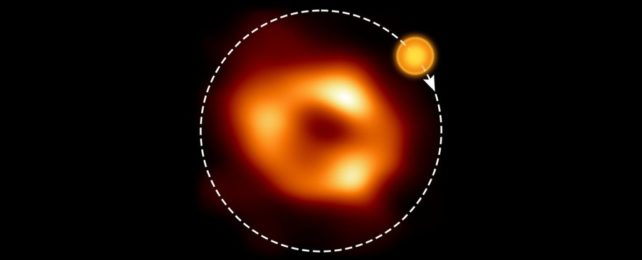In the wacky gravitational environment in the heart of our galaxy, astronomers have found a gas blob orbiting our supermassive black hole at superspeed.
Its characteristics are helping astronomers probe the space immediately surrounding Sagittarius A* in the search for answers about why the galactic center flickers and flares across the entire electromagnetic spectrum.
Their findings suggest that the black hole is surrounded by a clockwise-spinning disk of material modulated by a powerful magnetic field.
And confirms something that we already knew: The space around a black hole gets wild.
"We think we're looking at a hot bubble of gas zipping around Sagittarius A* on an orbit similar in size to that of the planet Mercury, but making a full loop in just around 70 minutes," says astrophysicist Maciek Wielgus of the Max Planck Institute for Radio Astronomy in Germany.
"This requires a mind-blowing velocity of about 30 percent of the speed of light!"
Sgr A* got a huge moment in the spotlight earlier this year when the Event Horizon Telescope collaboration unveiled an image of the black hole years in the making.
Telescopes around the world worked together to take observations of the galactic center, which combined to reveal the donut-shaped ring of material swirling around Sgr A*, heated up to incredible temperatures.
One of the telescopes included in the collaboration is the Atacama Large Millimeter/submillimeter Array (ALMA), a radio telescope array located in the Atacama desert in Chile.
While studying the data solely from ALMA, in isolation from the rest of the collaboration, Wielgus and colleagues noticed something interesting.
In April 2017, in the midst of data collection, the galactic center spat out an X-ray flare. It was just pure chance that it occurred while astronomers were collecting data for the Event Horizon Telescope project.
Previously, these long flares, observed in other wavelengths, have been associated with blobs of hot gas that orbit very close to the black hole and at very high speeds.
"What is really new and interesting is that such flares were so far only clearly present in X-ray and infrared observations of Sagittarius A*," Wielgus explains. "Here we see for the first time a very strong indication that orbiting hot spots are also present in radio observations."
It's thought that these flares are the result of the hot gas interacting with a magnetic field, and the team's analysis of the ALMA data supports this notion.
The hot spot emits light that is strongly polarized, or twisted, and displays the signature of synchrotron acceleration – both of which occur in the presence of a strong magnetic field.
And the glow in radio light could be the result of the hot spot cooling down after the flare, and becoming visible at longer wavelengths.
"We find strong evidence for a magnetic origin of these flares and our observations give us a clue about the geometry of the process," says astrophysicist Monika Mościbrodzka of Radboud University in the Netherlands.
"The new data are extremely helpful for building a theoretical interpretation of these events."
The team's analysis of the light suggests that the hot spot is embedded in a magnetically arrested disk. That's a disk of material that is swirling around and feeding into the black hole but at a rate that is hindered by the magnetic field.
Through modeling that integrated the data, the team was able to provide stronger constraints on the shape and motion of this magnetic field, and the formation and evolution of the hotspot within it.
But there's still a lot we don't know. Looking at black holes is really difficult, and there are some odd discrepancies when compared with infrared observations of other flares.
The team hopes that simultaneous infrared and radio observations of future hot spot flares in the future will help iron out these kinks.
"Hopefully, one day, we will be comfortable saying that we 'know' what is going on in Sagittarius A*," Wielgus says.
The research has been published in Astronomy & Astrophysics.
